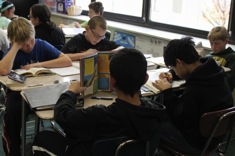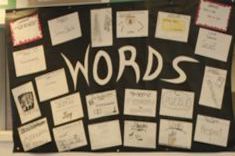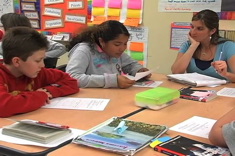Struggling readers need precisely what good readers receive—lots of high-success reading experiences.
Richard Allington
I’m not a fan of the words struggling reader. But in using them here, I am thinking about students who find that reading is a daily struggle, and because of this struggle, don’t yet feel comfortable or confident as readers. Something is holding them back from growing as readers in the same way many other kids are growing.
Over the past few years, I’ve had a handful of struggling readers in my classroom. I am convinced that reading workshop is the best structure for these struggling readers, because it is one that gives all students the time they need to grow from where they are. It also allows us, as teachers, to dig in and give these students just what they need through minilessons, small-group instruction, and individual conferring.
Struggling readers deserve what all readers deserve. But I notice that our most struggling students do not always get the benefits of the entire reading workshop. The focus on the instruction for our struggling readers—the explicit instruction, the pull-out intervention, and the small-group strategy work they need—is an important piece of our work with them. It is where I spend much of my planning time. But this year, I’ve realized that the planning for small groups or conferences is only one part of supporting a struggling reader. Targeted instruction alone is not enough to grow a reader. In the stress of the day and the rush to “catch kids up,” we often forget about all the other things readers need.
Explicit instruction alone does not make a reader. We want more for our students than for them to be readers who read “at level” and can pass tests. If we remember that larger goal, we’ll remember all the things that go into creating readers.
Daily Time for Independent Choice Reading
All students deserve daily time for choice reading in a classroom filled with great books, one in which a “just-right” book is not defined by level. More than anyone else, our struggling readers need books they can read, understand, and enjoy. And just as importantly, they have to have choice within those books.
For this to happen, the classroom has to have a good variety of books, but it also has to be a place that values lots of kinds of books. It doesn’t do any good for a child to be reading a short chapter book if everyone else in the classroom is reading a book the length of a Harry Potter book, because length is what is valued in the classroom. For children to become engaged in books, they need to be in a classroom where many kinds of books are valued for a variety of authentic reasons. I’m intentional about reading aloud and book-talking books that are accessible to lots of students. I also look for authors such as Jon Scieszka and Doreen Cronin who have picture books as well as novels, so the value is placed on an author we love rather than on the length or difficulty of a book.
Honest Feedback
I have found that readers who are struggling as readers know they are struggling. One of the best things we can do for these students is build a growth mindset. It is hard not to want to build kids up by praising all that they do and telling them how great they are doing, but honesty has to come first. For that to happen, we can’t use any fake or general praise. The praise has to be honest and specific. We have to be up front about what is going well and what challenges we notice in our work with them. So instead of saying, “Great job!” I name something they’ve done that I hope they continue doing, such as “Wow, I know comprehension has been hard for you as you move to longer books, but I noticed that today, you really stopped to think about what happened yesterday before you began reading and that helped you hold on to the story. Is this the first time you’ve tried that?” Honest talk with honest feedback is crucial for struggling students.
Ways into Whole-Class Lessons
Often, many students lose out on whole-class lessons. It is over their heads or the pace is too fast for them to keep up for some reason or another. Some of our struggling readers often require a bit more scaffolding for some lessons or access to a visual that they can revisit. They need more than one experience with a new idea to build understanding. I’ve found that visuals in a notebook are helpful, but I have also thought that front-loading students in small groups or conferring helps. For years, I used conferring and small-group time to intervene with students who didn’t understand things we had learned as a whole class, but I’ve started to use that time to teach a bit before a concept hits a minilesson. I have found that if I meet with a small group about theme a few times before we hit that idea in minilessons, the children from the group are comfortable with the idea and more confident about engaging in the lesson.
Time to Read Books That Are Not “Just Right”
My youngest daughter read one page of a Junie B. Jones book every night at bedtime for months in first grade. The book was much too hard for her, and it took a great deal of work every single night for her to get through it. I’d listen from my room next door as she would read aloud to herself, and I could hear the struggle. The book wasn’t just right for her, and she knew it. But she also knew she could work through it a little at a time. This was a milestone of her reading life as she spent a bit of time each day stretching beyond her comfort level but not at the expense of books she could enjoy more.
We’ve taken the idea of just-right books a bit too far. Of course every child needs time each day to read books that are at the right level. But every minute of every day does not have to be in a just-right book.
Time to Talk
I recently heard Dan Feigelson talk at the All Write Summer Institute. He told us that the words Say more about that are often our best friends during reading conferences. I do a great deal of listening with my readers, but if I am honest with myself, I notice that I tend to talk far more and listen far less when conferring with my struggling readers than with others in the class. I often try to control more of my struggling readers’ time.
I notice that they do not get the time to talk to peers or to me as much as others because I am so busy “teaching.” Because I worry about how far behind some students are, I am in more of a hurry, so I often cut this critical piece of listening. I need to be aware of this so that I make sure to give my struggling readers time to talk.
The combination of honest feedback and giving kids time to talk helps me better support students. Children are more apt to tell me things that they know they are confused about that they’ve been covering up. They are much more comfortable talking to me about their reading—the celebrations and challenges—when I give them time to talk and I give myself time to listen.
A Chance to Feel Part of a Community of Readers
Every reader in our classroom must be equally important to our community. Our less-confident readers are often reluctant to share their strategies and to ask questions. Often, our struggling readers don’t feel like they have anything to offer to the classroom community. For me, that means I have to work harder to help them feel part of the community. When I notice a smart strategy they are using, I ask them to share it with the whole class so others can learn from them. Or I might invite a struggling reader to share a book he or she has read with another reader in the class who has previewed it and is deciding whether to read it. For all students to feel part of the community, each one needs opportunities to learn from and give to the community in some way.
Small Groups That Push the Ideas We Have About Guided Reading
Small-group work is critical for all students, especially for those who are struggling. But I am careful to do more than guided reading in my small-group instruction so that kids have time to talk and process and take charge of their own reading. I definitely think there is a place for guided reading, but I know if my students are only with other students reading at their level, many opportunities for growth are not there. They need opportunities with lots of readers to respond to texts in various ways. All of my readers are in small groups based on need, not level.
Read-Aloud Time
Often struggling students are pulled out during read-aloud time, and I’ve found that this is one of the most important times for the class reading community. Because our struggling students often cannot read books that are as sophisticated or complex as their thinking is, the texts they can read independently are often a bit below their emotional or maturity level. Read-aloud allows all students to engage in conversations around stories and discussions that push their thinking as readers while taking away the struggle of reading the text independently.
Some Downtime? Time for Work They Love
I notice that my struggling readers sometimes also struggle in other areas. It is tiring to do hard work for long periods of time, and we ask our struggling students to do that every single day. Without breaks and without work they love and are confident about, our struggling readers can lose their energy for learning. Every child deserves learning joy every day.
When I think about my students’ days and the interventions they need, I try to keep in mind all that a student deserves and that intervention alone does not make a reader. The decisions I make about these children have to honor their needs as readers and give them opportunities that go beyond targeted interventions.









